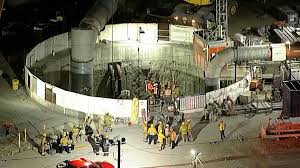
Construction on one of Los Angeles County’s largest wastewater infrastructure projects remains frozen as officials, engineers and contractors grapple with the aftermath of a partial tunnel collapse that has left a tunnel boring machine stranded deep below the surface.

On July 9, a section of the Los Angeles Effluent Outfall Tunnel, part of the Sanitation Districts’ Clearwater Project, gave way 370 feet underground near Carson, California. “Work on the tunnel remains at full stop,” Michael Chee, spokesperson for the Los Angeles County Sanitation Districts, confirmed on July 28. “Red tag placed by CalOSHA remains in force.”
Signs of trouble emerged months earlier. According to Robert Ferrante, chief engineer and general manager of the LA County Sanitation Districts, “The ground exerted high pressure on the area,” causing the tunnel lining’s segment rings to deform. As far back as February, crews noted that the intense pressure was “resulting in the ‘squeezing’ of the segment rings creating ovalization of those rings and some cracking.”
Flatiron/Dragados, the joint venture building the tunnel, acted on recommendations to mitigate the stress, but the ground continued to shift. When the breach finally occurred, the TBM was more than 4,000 feet past the original “squeezing” zone — a reminder that underground work in an active fault region can be unpredictable despite modern engineering.
The 7-mile Clearwater Tunnel runs through complex geology and crosses two active fault lines: the Palos Verdes Fault Zone and the Cabrillo Fault Zone. A 2022 Mining Engineering feature noted the tunnel would pose significant geotechnical challenges because of deep soft soils, fault crossings, high groundwater pressure and seismic considerations. These risks add engineering costs — and unexpected delays can multiply them.
.jpg)
The partial collapse could have turned deadly. Instead, workers escaped thanks to rapid response and safety planning. Twenty-seven tunneling crew members scrambled through unstable conditions, climbing over a mountain of displaced soil to reach the only exit — five miles from the collapse point. Four more workers who rushed in to help with rescue efforts also emerged safely. The tunnel’s depth and single entrance complicated the rescue, highlighting how high-risk underground work remains, even with modern equipment.
Fortunately, the damaged tunnel segment carries treated effluent, not raw sewage, meaning no hazardous spill occurred. The Sanitation Districts say the environment is not at risk, and there is “no information to suggest that any local streets or surface areas above tunnel construction have been compromised,” Ferrante’s letter said. Nevertheless, daily surveys are monitoring the ground above for any signs of movement.
The Clearwater Project broke ground in 2019 to replace two aging ocean outfall pipes and to ensure the region’s wastewater system meets earthquake safety standards while adding capacity for major storms. The new tunnel alignment avoids running beneath homes, staying mostly within public rights-of-way. But the engineering complexity — and now the unexpected stoppage — raise questions about cost overruns, extended delays and possible impacts for local ratepayers funding the project.
The construction joint venture Flatiron West and Dragados USA, which merged in 2024 to form FlatironDragados, must now develop an access plan to safely reach the collapsed section. But no timeline has been given for when crews can re-enter, assess damage or restart mining. Until then, the TBM sits idle underground — an expensive pause that puts pressure on the contractors and the sanitation authority alike.
Work continues above ground at Royal Palms Beach in San Pedro, where the TBM will eventually surface, but the core tunneling work is frozen. Originally expected to finish in 2027, the project’s completion date is now in limbo. Any significant delay could ripple through local budgets, future wastewater rates and planned upgrades tied to the tunnel’s opening.
With so much uncertainty, local leaders and residents are demanding transparency. The Sanitation Districts will host a town hall on August 9 to brief the community on the incident, safety measures, and the path forward. Residents want assurances that the remaining tunnel route — with its active fault crossings and history of ground pressure surprises — won’t pose future risks to workers or surrounding neighborhoods.
Officials say they share the community’s concern. “We are committed to prioritizing worker safety and will pursue any and all corrective measures necessary to complete construction of this vital infrastructure project once all safety concerns have been thoroughly addressed,” Ferrante’s letter emphasized.
Until the investigation reveals the exact cause of the breach and the stability of the surrounding geology, the massive TBM remains entombed under Carson’s soil. Project engineers must now determine whether reinforcing the tunnel lining will be enough — or whether more complex redesigns are needed for the remaining sections.
Meanwhile, the breach is another reminder of how major infrastructure projects, even ones that stay hidden underground, can carry hidden risks that surface when least expected.
Originally reported by Julie Strupp in Construction Dive.